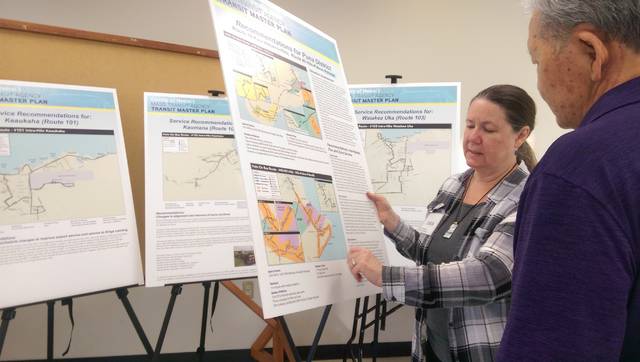HILO — Big Island bus ridership has dropped by almost a third over the past four years, mostly due to unreliability of an aging fleet, consultants said Monday.
HILO — Big Island bus ridership has dropped by almost a third over the past four years, mostly due to unreliability of an aging fleet, consultants said Monday.
About two dozen people, from regular riders to county officials to bus drivers, came to the final of five public meetings on a proposed master plan. Consultants plan a second round of hearings after the draft master plan is completed in early 2018.
Some riders were passionate about improvements they say are needed to make buses on their particular route more reliable. Others lamented having to stand as long as two hours because buses, especially those ferrying hotel workers across island, are too full.
And some worried that the bus isn’t safe for children.
The County Council voted in 2015 to have the $500,000 study done, and Honolulu-based SSFM International was chosen to conduct it. It’s the first time in the bus system’s 40-year history a master plan has been attempted.
“We feel we can get them back if the buses are reliable,” said SSFM’s Cheryl Soon, adding that a fare hike and low gas prices may have also contributed to the drop.
Still, she said, “there are a lot of people who want this to be their first choice.”
The island’s buses transport just under a million passengers annually, consultants said.
The bus system is primarily a commuter system, and several human resources officials and hiring agencies were at a recent meeting in Kona, describing how most of the jobs are on the west side of the island, while most of the applicants live on the east side. An express Hilo-Kona route could be incorporated as a solution to that problem, Soon said.
Hele-On is currently at a crossroads.
A full 25 of the 55-bus fleet were out of commission when Mayor Harry Kim took over in December because they needed major repairs. Since then, former Transit Administrator Tiffany Kai has been reassigned, and consultant Curt Sharp was contracted to bring the system up to snuff. Sharp’s contract has since lapsed.
The search for a permanent administrator continues, with a solicitation for applications ending at 11:59 p.m. today. The pay was hiked to $69,084-$127,284 annually after a previous solicitation drew few qualified candidates.
The system is still struggling with a shortage of working buses, and the county is still spending thousands of dollars a day for backup buses and drivers from private companies.
A hub and spoke system would make better use of resources by having the big county buses drive the major thoroughfares, picking up passengers that are brought to a community hub by smaller buses and vans. That process saves fuel and wear and tear while providing more flexibility and less walking to bus stops by passengers.
A financial plan will be drafted for the County Council and administration to use as a budgeting tool.
The council budgeted $14 million this year for transit operations and improvements, up slightly from last year. Half of the money comes from the general fund, which comes primarily from property taxes, and half comes from the highway fund, collected from gas taxes and franchise fees to utilities.
Federal grants account for just $1.2 million of the budget, and with fares accounting for $960,000, the county pays an average $11.77 per rider. Riders pay $1-$2 fares, depending on their age and whether they have disabilities.
No matter how many riders pay fares and how much the county gets in federal grants, there will continue to be a requirement for the county to chip in, said Soon.

